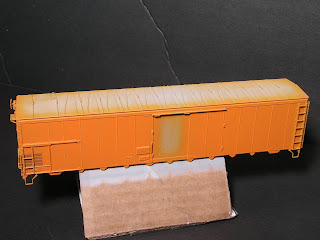Progress is being made towards completion of SFRP 2106, but it has not been without some difficulties. The lack of Scalecoat II Reefer Orange really had me digging deep for possible paints to use. I unearthed several old bottles of Floquil Military colors such as Orange and Bright Orange, Modelflex SP Daylight Orange, and finally I decided to go with Tamiya Acrylic gloss colors. While not a Santa Fe modeler, I experimented with several shades that looked appropriate for the mechanicals and decided to custom mix my own using their gloss line of colors. I prefer to use Scalecoat II paint as it is easily decaled and is one of the easiest to use paints on the market, but having used Tamiya Acrylics in the past with success, I chose this route for the sake of not having to apply additional clear coats which is where I tend to see the most difficulties with inclusions and humidity.
In 1963, Santa Fe modified their paint scheme to a darker shade of orange. Using the prototype image I had on hand, and knowing that my final color will become muted once a final coat of Scalecoat II flat glaze is applied, I drifted the color to capture a darker hue. The mixing ratio was 15:1:1 of Tamiya X-8 (Lemon Yellow), Tamiya X-6 (Orange), Tamiya X-7 (Red). The color looks really good for Illinois Central and ICG Orange as well.
The ratio was mixed in a 2:1 paint to thinner (Tamiya Lacquer Thinner was used in place of Tamiya Acrylic Thinner) ratio and applied at approximately 1" to 2" from the surface. The model was primed using Tamiya Fine Surface Primer prior to airbrushing the paint mixture at 13 PSI. There are still areas which need to be touched up due to detail obstructions overlaying the model, but these are largely hidden and will be addressed.
One note of interest was I initially used my Paasche Talon with a .68 tip, and found that while excellent for detail painting, it struggled at the lower PSI to give me a good base coat. This resulted in some tiger striping along the panel lines, so I brought in my old reliable Paasche H and eliminated the issue with a broader spray pattern.
Here are some overall images of the model as it sits awaiting one last round with my airbrush. There is still masking to be done as well to include the sill edges which will be painted black, and the roof will receive a coat of Model Master steel to more accurately reflected the sun beaten prototype's appearance.
While airbrushing, I also removed the door rods and tracks and gave those a good coat which were unaffected by the thinner spray pattern of the Talon.
The door rods will need some additional detail painting to follow the prototype's appearance as they were painted to match the door on the prototype image I am using. The doors were far easier to address, which included sanding them thinner to remove the extra thickness, and a good primer coat. Once dry, I airbrushed the doors using Scalecoat II Santa Fe blue and allowed those to fully cure.
I was anticipating the Tamiya paint to leave a glossy finish such as that found on the doors, but it is inherently different paint than Scalecoat II which I have been using since the demise of Floquil. If I choose to go with another paint, it will be a mix of Scalecoat II Reefer Orange if I can locate a bottle, but with the upheaval at MinuteMan Scale Models, there is not much selection or choice other than hunting down old stock.
Lastly, the underframe components have not been modified as I am awaiting a copy John Moore's Mechanical Refrigerator Cars of the Santa Fe to arrive for closer inspection of the details.
The model has received an improved Kadee Champion brake wheel as one of the detail upgrades, and I plan to use Moloco 70 ton ASF roller bearing trucks until the release of the better trucks under development by Plate C Model Prototypes. The decals will be a mixture of those found on Microscale's 87-255 and 87-510. Overall, the Rapido model has excellent attributes, but could stand some finer details such as the brake wheel and trucks.






No comments:
Post a Comment